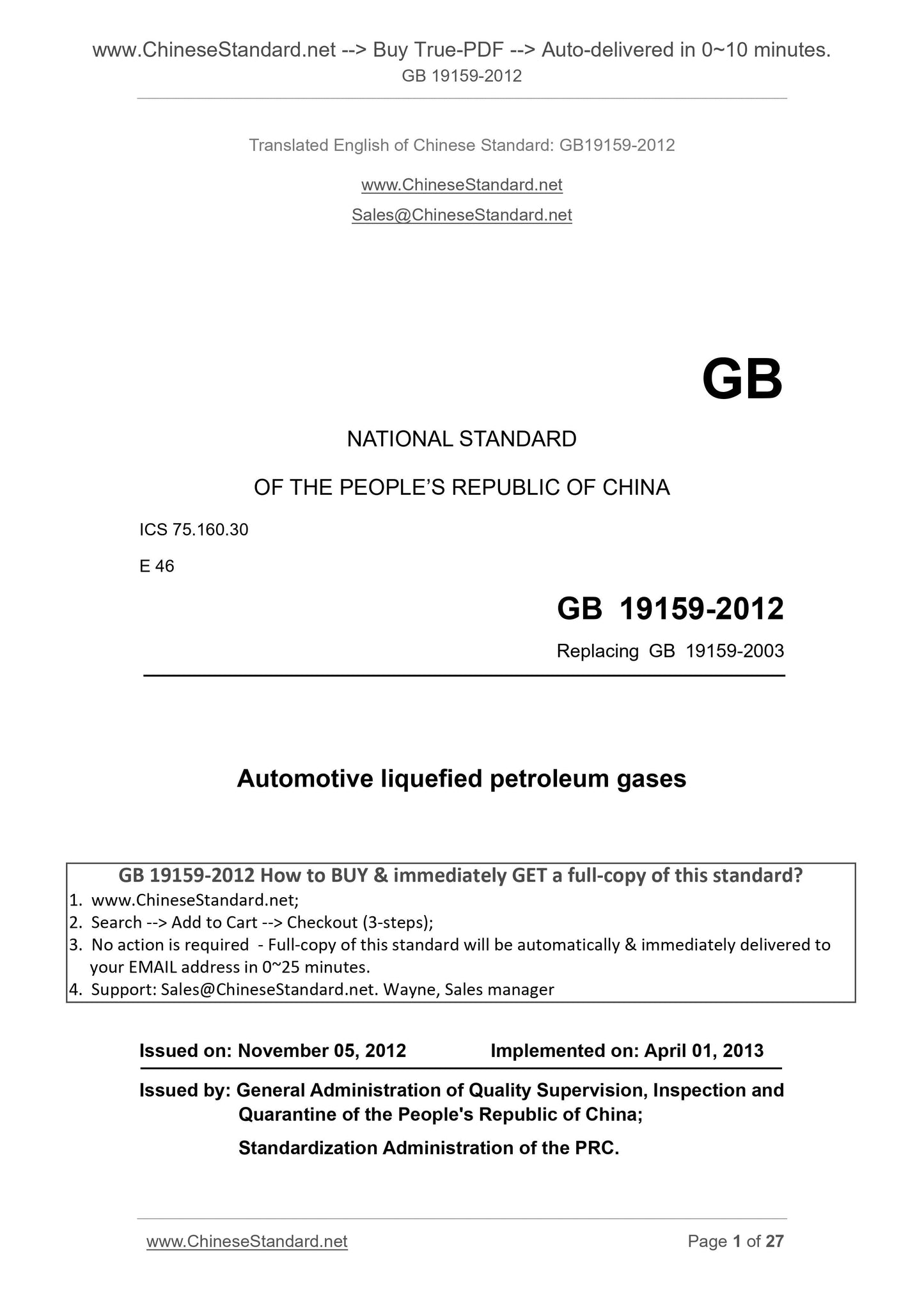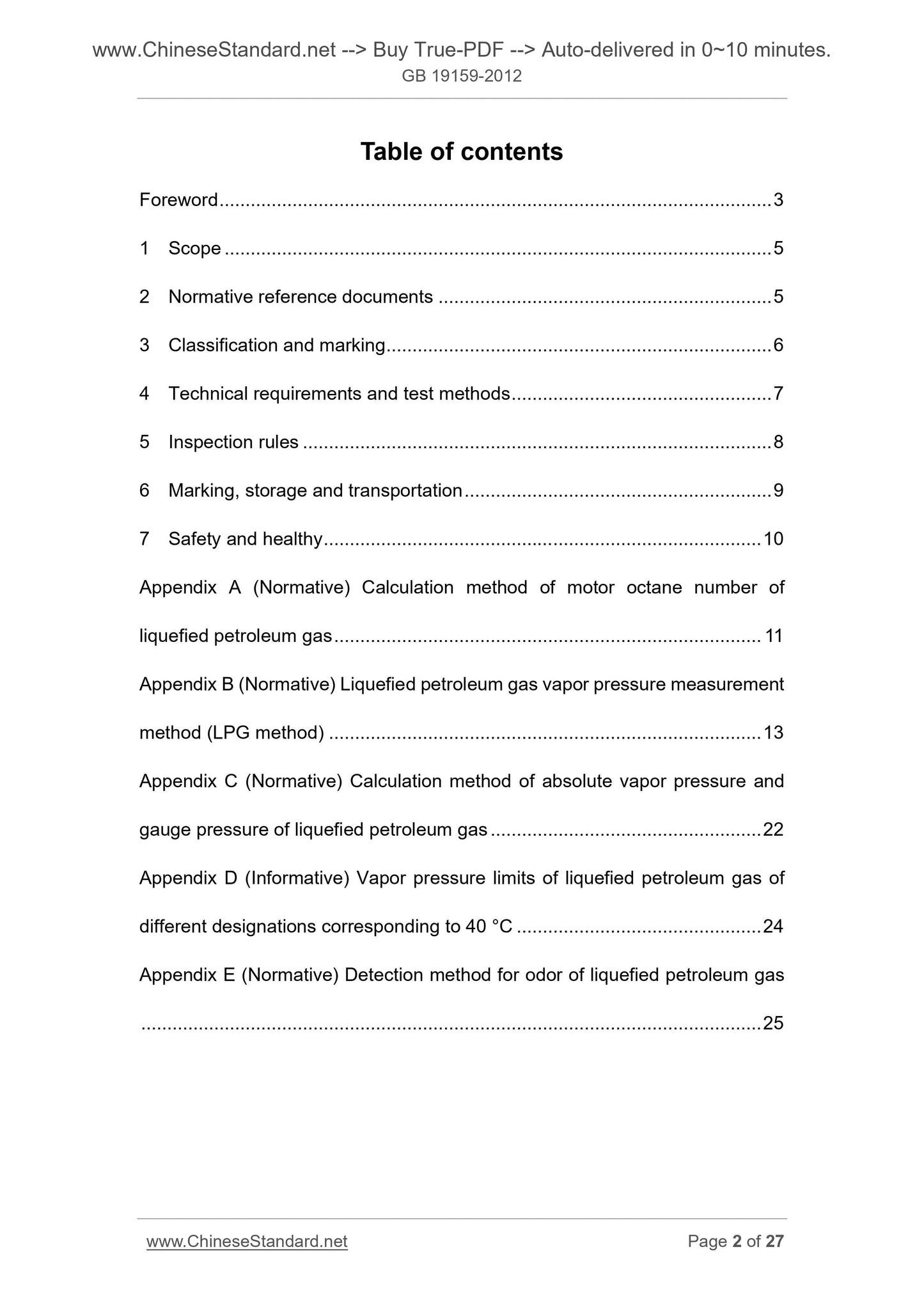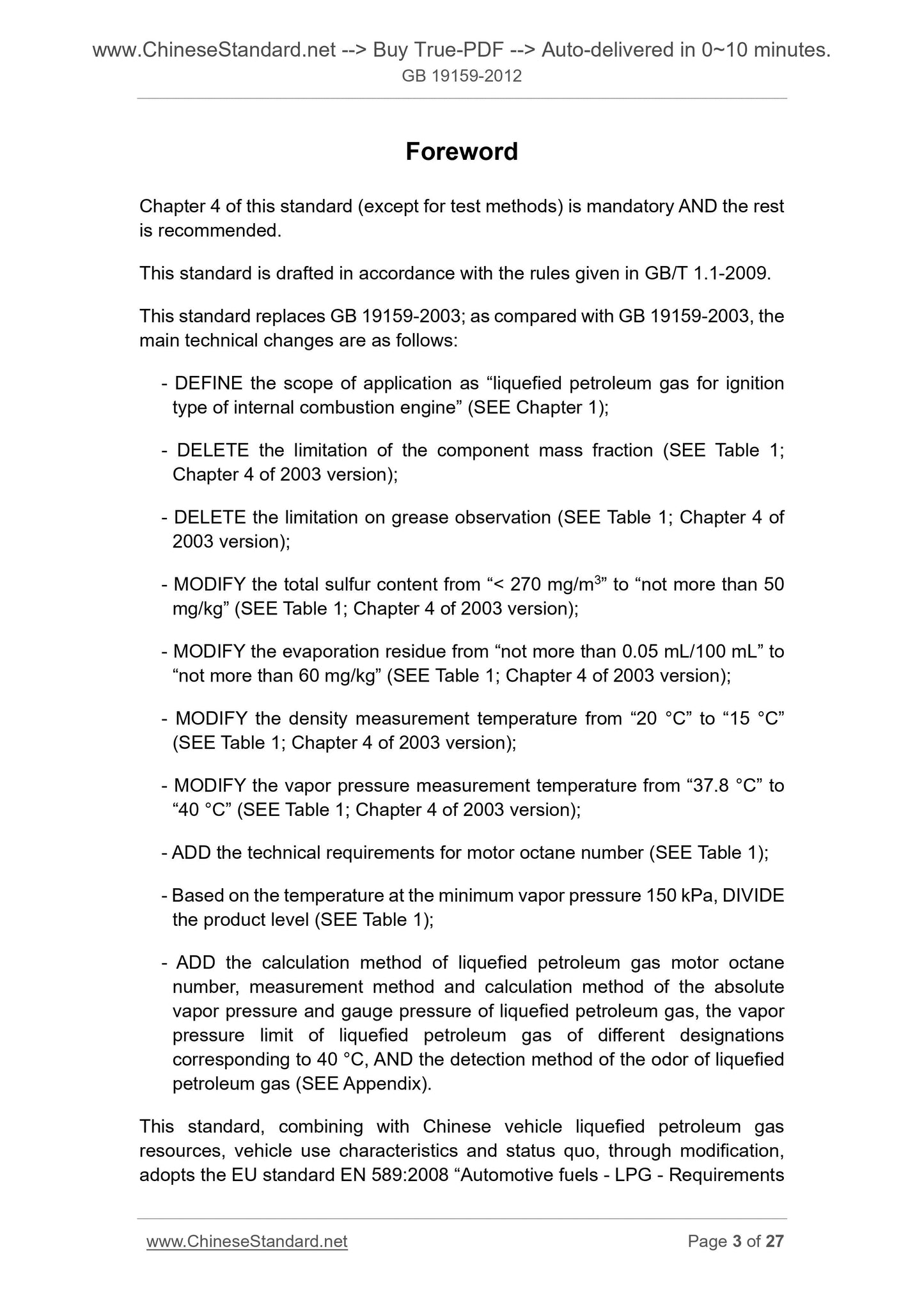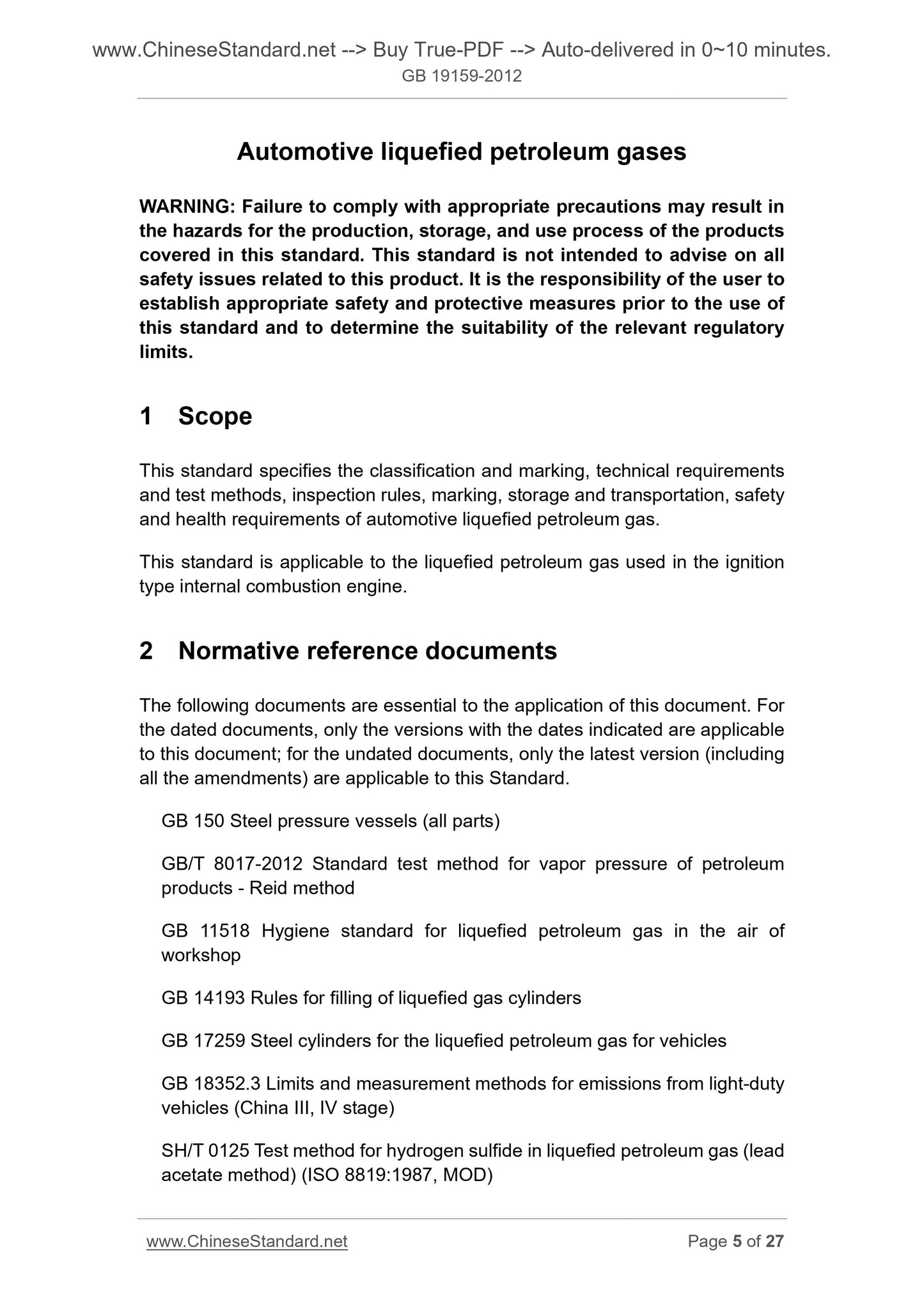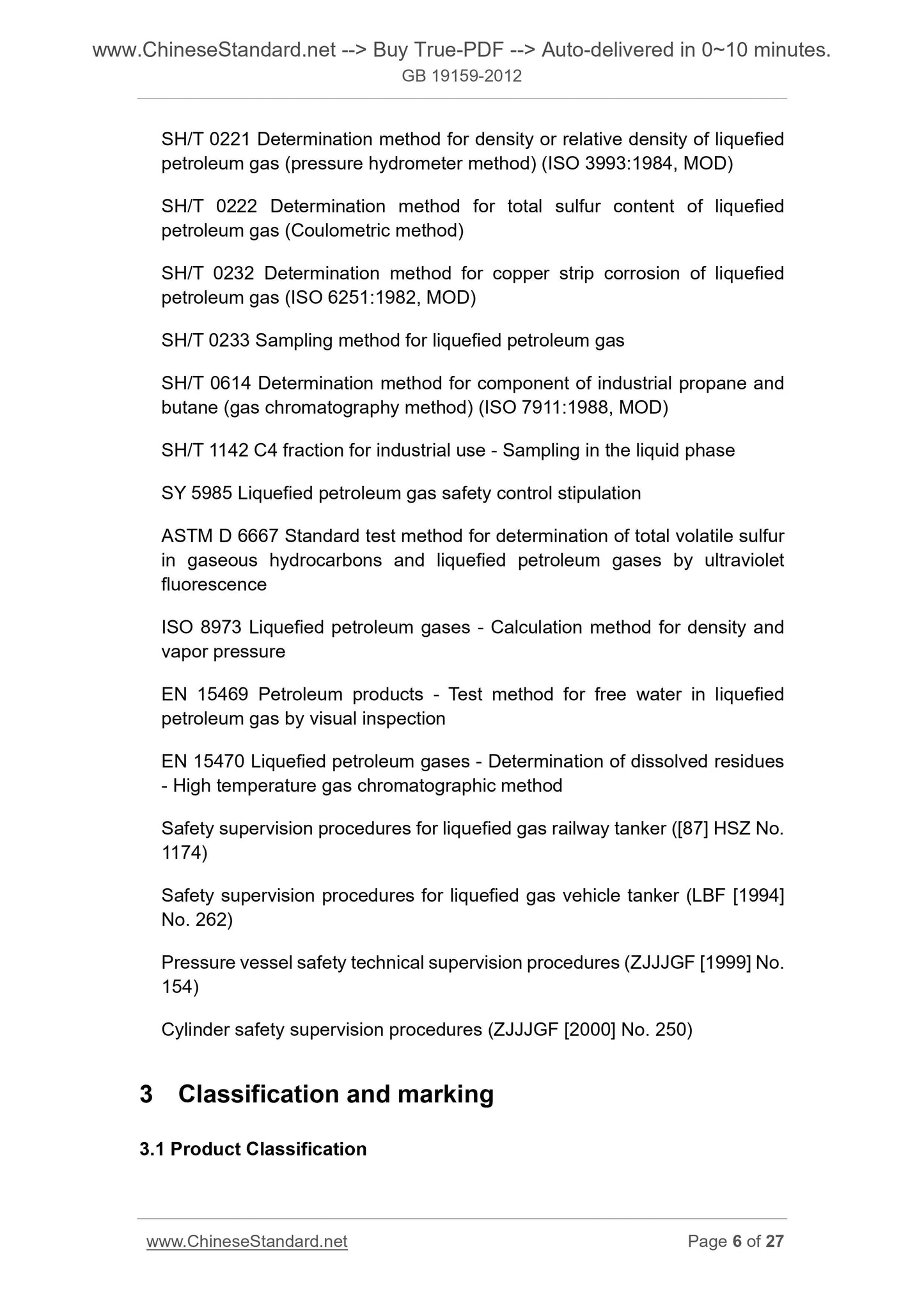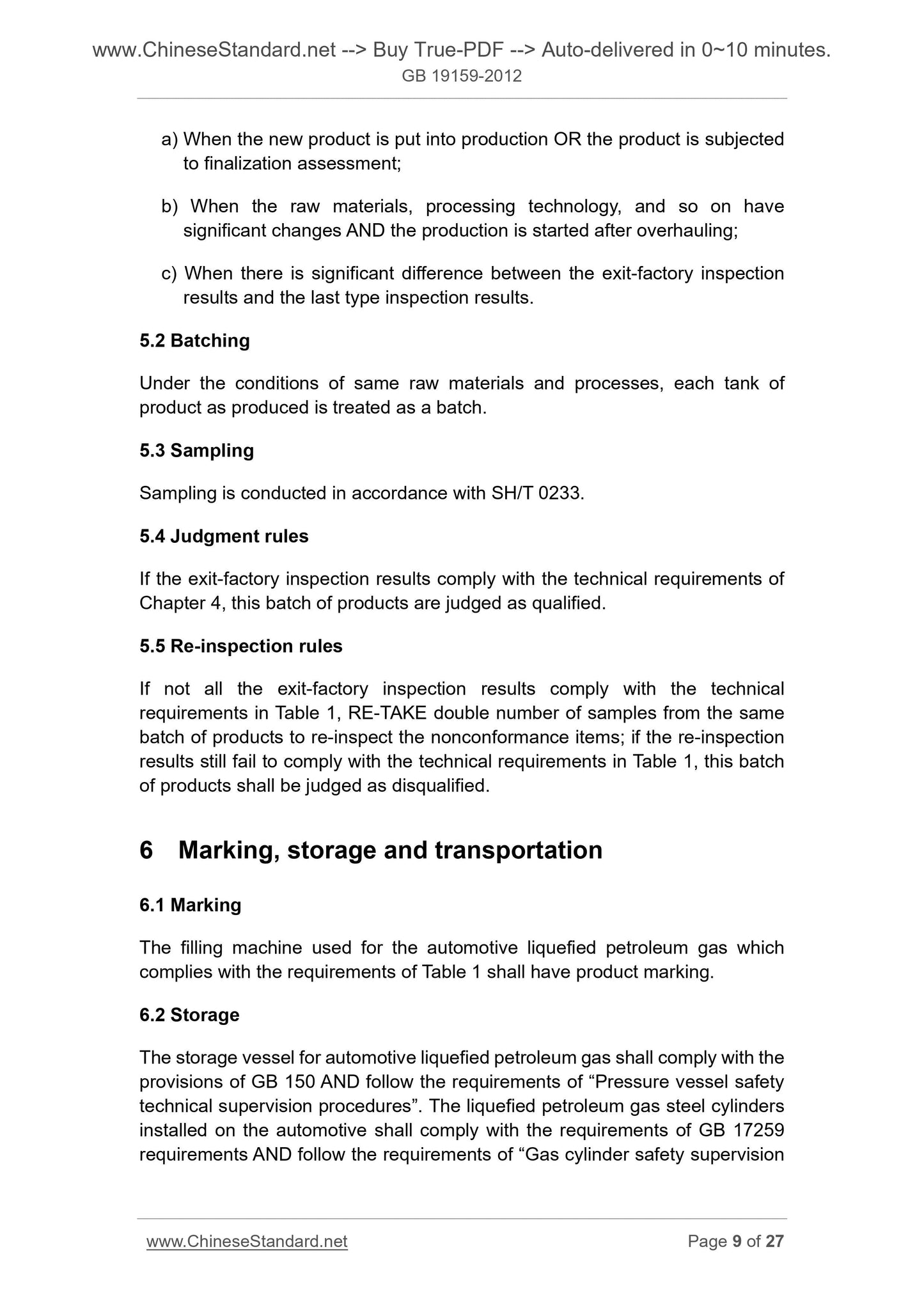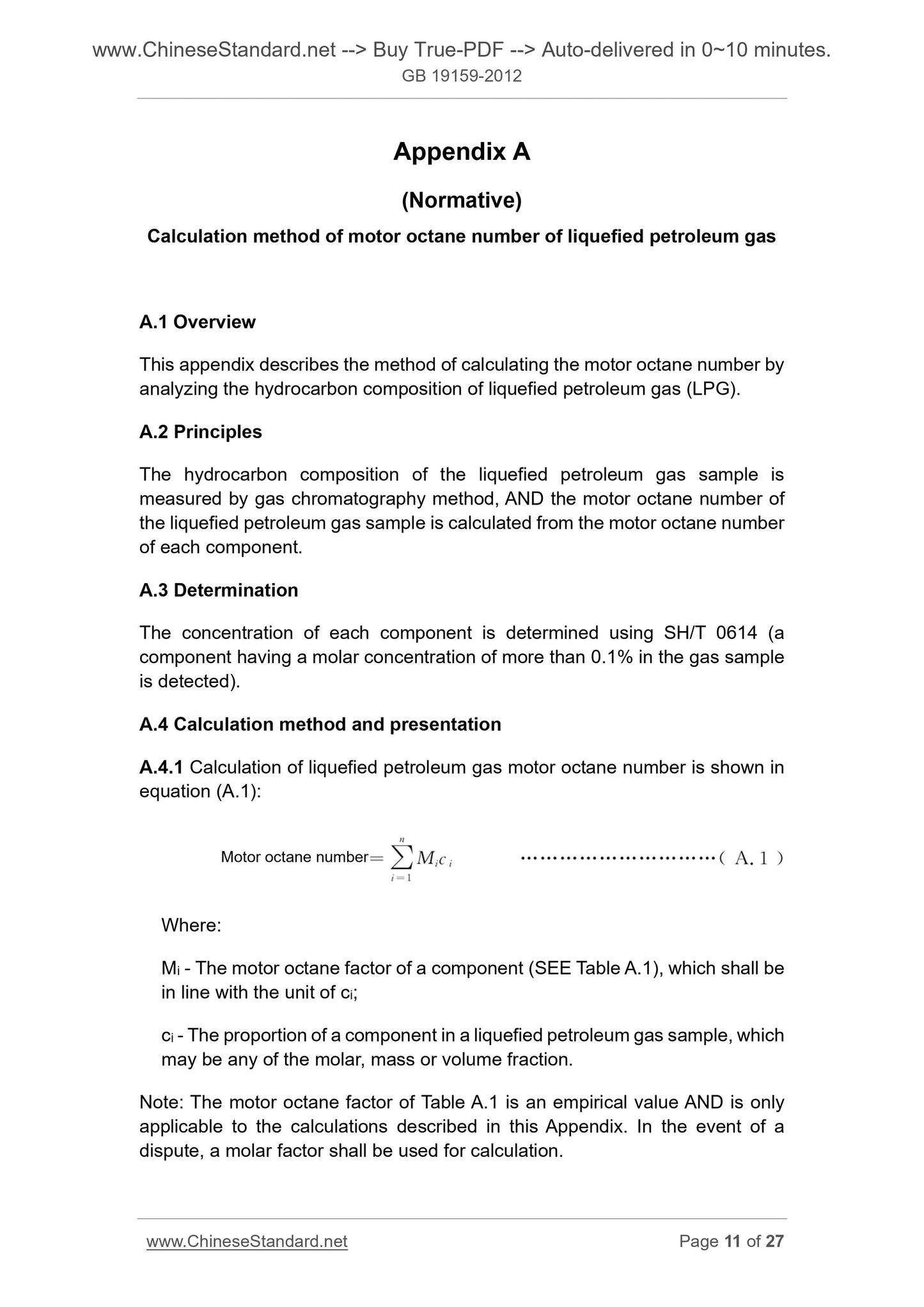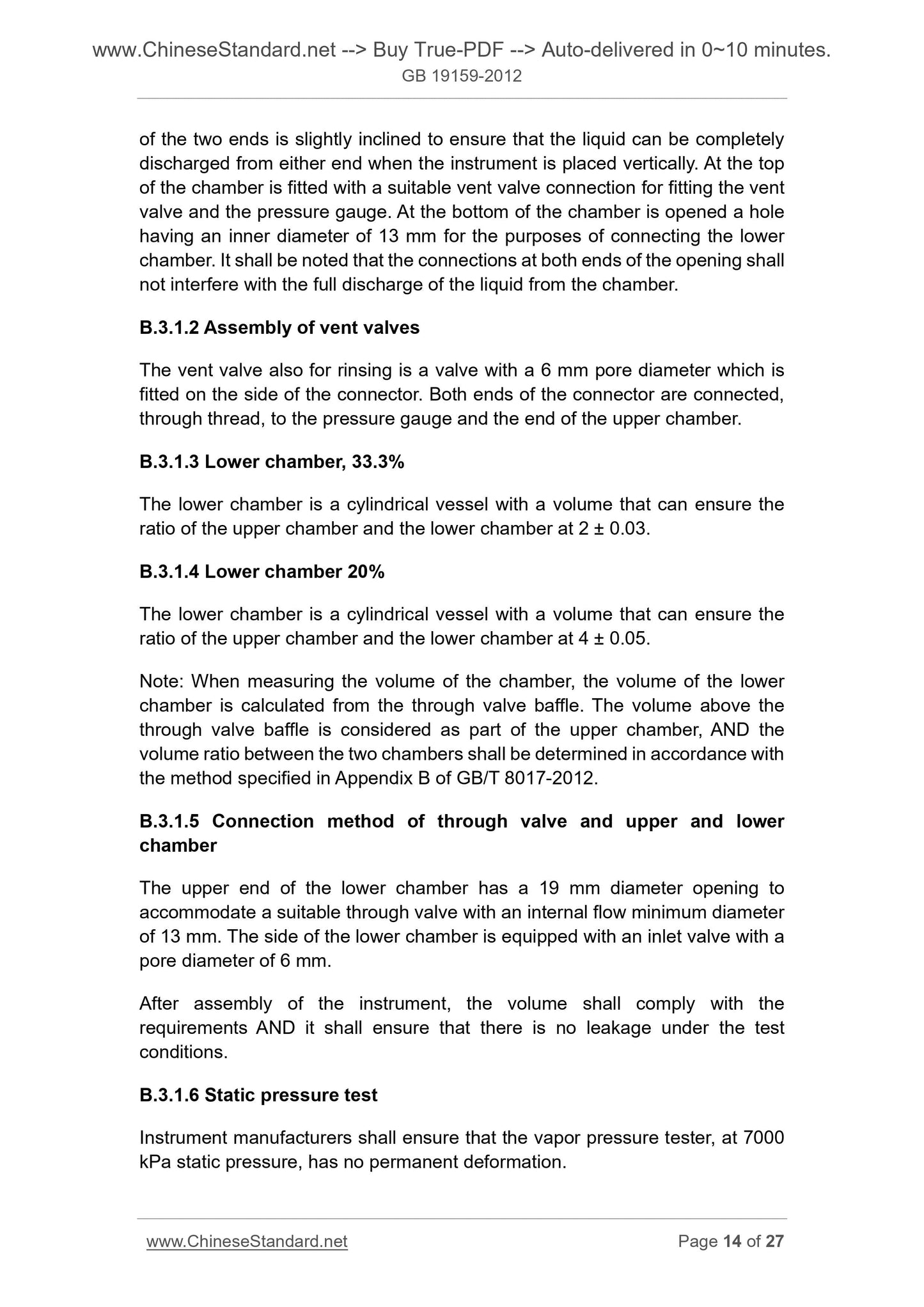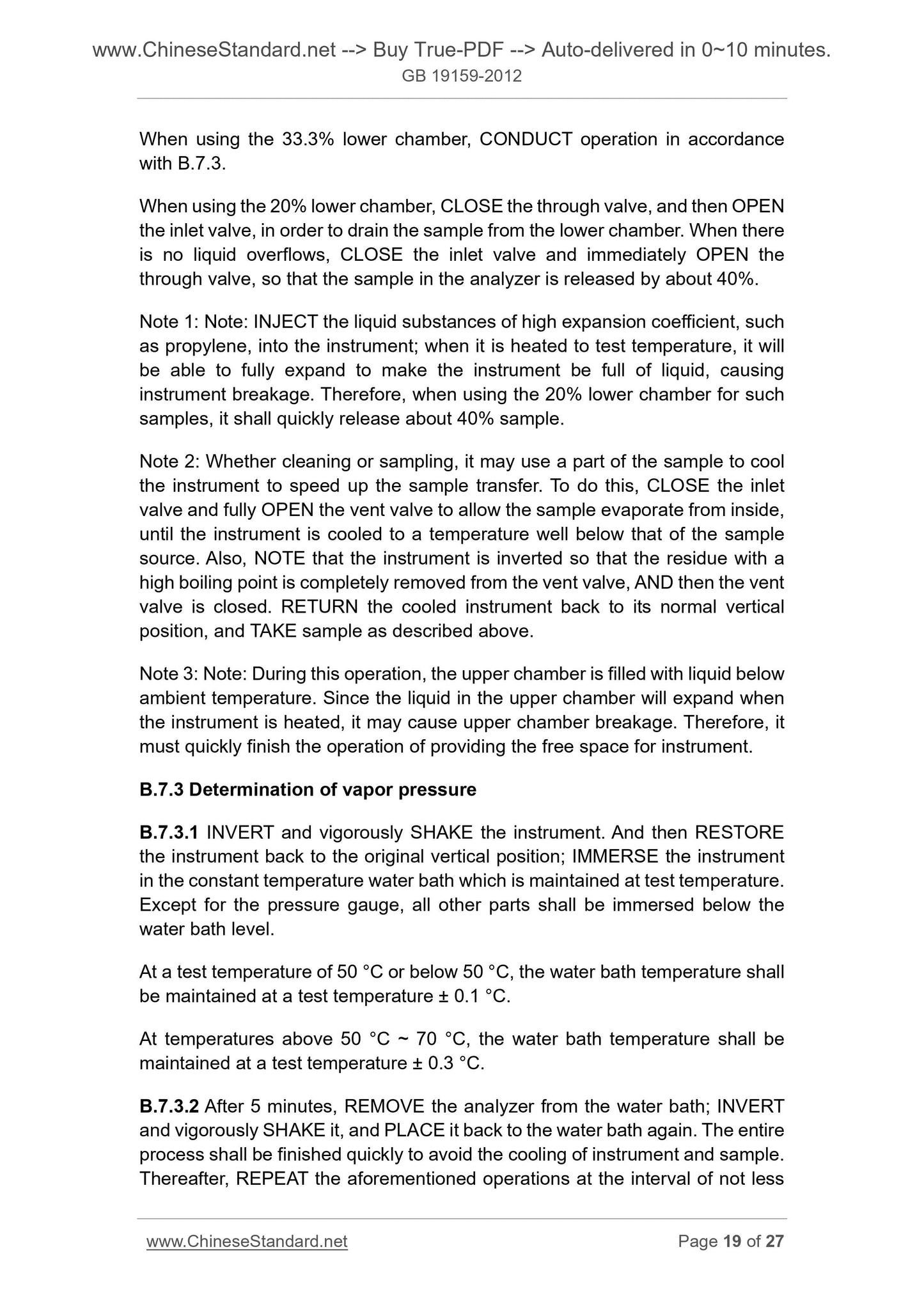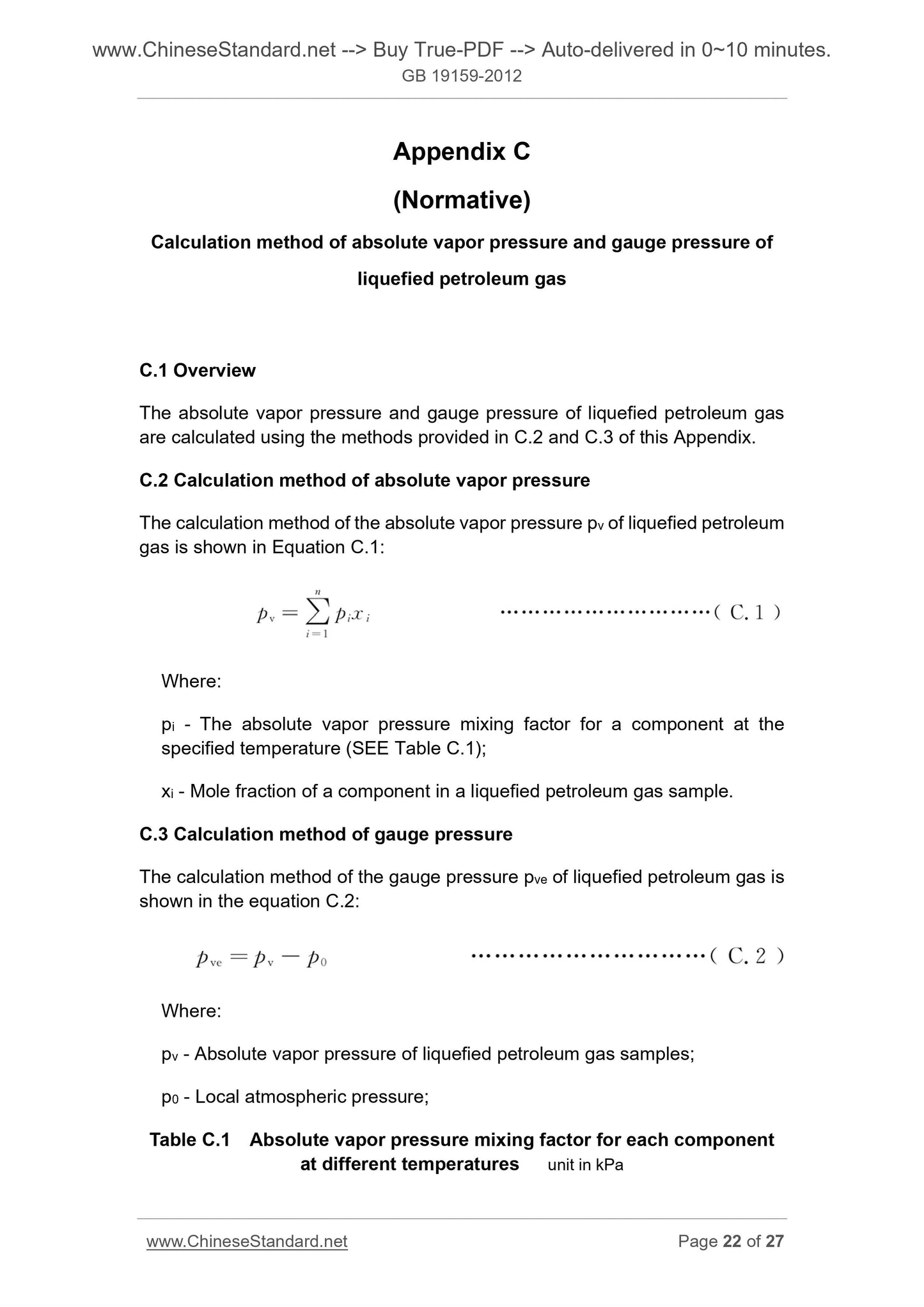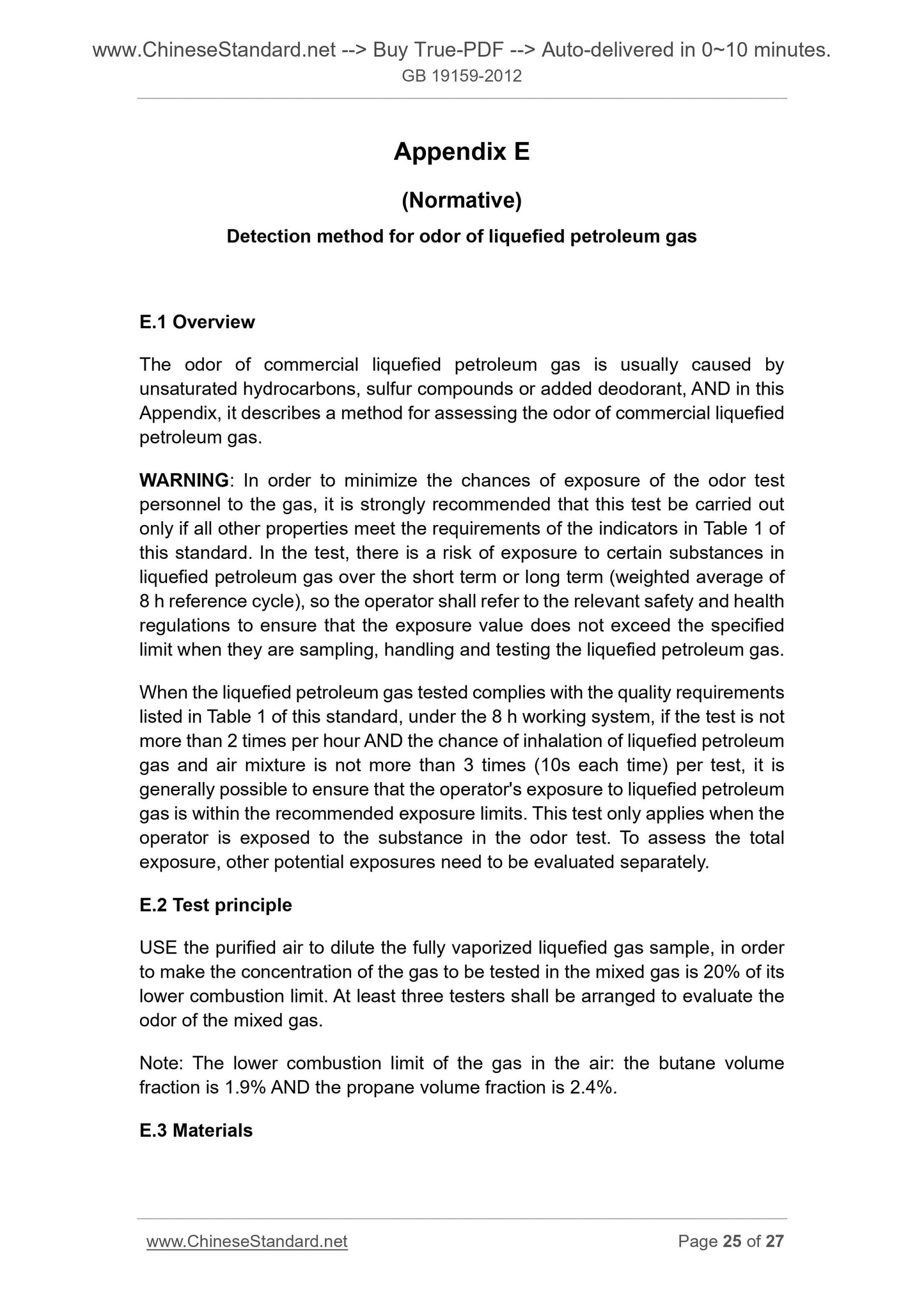1
/
of
11
PayPal, credit cards. Download editable-PDF & invoice In 1 second!
GB 19159-2012 English PDF
GB 19159-2012 English PDF
Regular price
$150.00 USD
Regular price
Sale price
$150.00 USD
Unit price
/
per
Shipping calculated at checkout.
Couldn't load pickup availability
Delivery: 3 seconds. Download true-PDF + Invoice.
Get QUOTATION in 1-minute: Click GB 19159-2012
Historical versions: GB 19159-2012
Preview True-PDF (Reload/Scroll if blank)
GB 19159-2012: Automotive liquefied petroleum gases
GB 19159-2012
GB
NATIONAL STANDARD
OF THE PEOPLE’S REPUBLIC OF CHINA
ICS 75.160.30
E 46
Replacing GB 19159-2003
Automotive liquefied petroleum gases
ISSUED ON. NOVEMBER 05, 2012
IMPLEMENTED ON. APRIL 01, 2013
Issued by. General Administration of Quality Supervision, Inspection and
Quarantine of the People's Republic of China;
Standardization Administration of the PRC.
Table of contents
Foreword ... 3
1 Scope ... 5
2 Normative reference documents ... 5
3 Classification and marking ... 6
4 Technical requirements and test methods ... 7
5 Inspection rules ... 8
6 Marking, storage and transportation ... 9
7 Safety and healthy ... 10
Appendix A (Normative) Calculation method of motor octane number of
liquefied petroleum gas ... 11
Appendix B (Normative) Liquefied petroleum gas vapor pressure measurement
method (LPG method) ... 13
Appendix C (Normative) Calculation method of absolute vapor pressure and
gauge pressure of liquefied petroleum gas ... 22
Appendix D (Informative) Vapor pressure limits of liquefied petroleum gas of
different designations corresponding to 40 °C ... 24
Appendix E (Normative) Detection method for odor of liquefied petroleum gas
... 25
Foreword
Chapter 4 of this standard (except for test methods) is mandatory AND the rest
is recommended.
This standard is drafted in accordance with the rules given in GB/T 1.1-2009.
This standard replaces GB 19159-2003; as compared with GB 19159-2003, the
main technical changes are as follows.
- DEFINE the scope of application as “liquefied petroleum gas for ignition
type of internal combustion engine” (SEE Chapter 1);
- DELETE the limitation of the component mass fraction (SEE Table 1;
Chapter 4 of 2003 version);
- DELETE the limitation on grease observation (SEE Table 1; Chapter 4 of
2003 version);
- MODIFY the total sulfur content from “< 270 mg/m3” to “not more than 50
mg/kg” (SEE Table 1; Chapter 4 of 2003 version);
- MODIFY the evaporation residue from “not more than 0.05 mL/100 mL” to
“not more than 60 mg/kg” (SEE Table 1; Chapter 4 of 2003 version);
- MODIFY the density measurement temperature from “20 °C” to “15 °C”
(SEE Table 1; Chapter 4 of 2003 version);
- MODIFY the vapor pressure measurement temperature from “37.8 °C” to
“40 °C” (SEE Table 1; Chapter 4 of 2003 version);
- ADD the technical requirements for motor octane number (SEE Table 1);
- Based on the temperature at the minimum vapor pressure 150 kPa, DIVIDE
the product level (SEE Table 1);
- ADD the calculation method of liquefied petroleum gas motor octane
number, measurement method and calculation method of the absolute
vapor pressure and gauge pressure of liquefied petroleum gas, the vapor
pressure limit of liquefied petroleum gas of different designations
corresponding to 40 °C, AND the detection method of the odor of liquefied
petroleum gas (SEE Appendix).
This standard, combining with Chinese vehicle liquefied petroleum gas
resources, vehicle use characteristics and status quo, through modification,
adopts the EU standard EN 589.2008 “Automotive fuels - LPG - Requirements
Automotive liquefied petroleum gases
WARNING. Failure to comply with appropriate precautions may result in
the hazards for the production, storage, and use process of the products
covered in this standard. This standard is not intended to advise on all
safety issues related to this product. It is the responsibility of the user to
establish appropriate safety and protective measures prior to the use of
this standard and to determine the suitability of the relevant regulatory
limits.
1 Scope
This standard specifies the classification and marking, technical requirements
and test methods, inspection rules, marking, storage and transportation, safety
and health requirements of automotive liquefied petroleum gas.
This standard is applicable to the liquefied petroleum gas used in the ignition
type internal combustion engine.
2 Normative reference documents
The following documents are essential to the application of this document. For
the dated documents, only the versions with the dates indicated are applicable
to this document; for the undated documents, only the latest version (including
all the amendments) are applicable to this Standard.
GB 150 Steel pressure vessels (all parts)
GB/T 8017-2012 Standard test method for vapor pressure of petroleum
products - Reid method
GB 11518 Hygiene standard for liquefied petroleum gas in the air of
workshop
GB 14193 Rules for filling of liquefied gas cylinders
GB 17259 Steel cylinders for the liquefied petroleum gas for vehicles
GB 18352.3 Limits and measurement methods for emissions from light-duty
vehicles (China III, IV stage)
SH/T 0125 Test method for hydrogen sulfide in liquefied petroleum gas (lead
acetate method) (ISO 8819.1987, MOD)
SH/T 0221 Determination method for density or relative density of liquefied
petroleum gas (pressure hydrometer method) (ISO 3993.1984, MOD)
SH/T 0222 Determination method for total sulfur content of liquefied
petroleum gas (Coulometric method)
SH/T 0232 Determination method for copper strip corrosion of liquefied
petroleum gas (ISO 6251.1982, MOD)
SH/T 0233 Sampling method for liquefied petroleum gas
SH/T 0614 Determination method for component of industrial propane and
butane (gas chromatography method) (ISO 7911.1988, MOD)
SH/T 1142 C4 fraction for industrial use - Sampling in the liquid phase
SY 5985 Liquefied petroleum gas safety control stipulation
ASTM D 6667 Standard test method for determination of total volatile sulfur
in gaseous hydrocarbons and liquefied petroleum gases by ultraviolet
fluorescence
ISO 8973 Liquefied petroleum gases - Calculation method for density and
vapor pressure
EN 15469 Petroleum products - Test method for free water in liquefied
petroleum gas by visual inspection
EN 15470 Liquefied petroleum gases - Determination of dissolved residues
- High temperature gas chromatographic method
Safety supervision procedures for liquefied gas railway tanker ([87] HSZ No.
1174)
Safety supervision procedures for liquefied gas vehicle tanker (LBF [1994]
No. 262)
Pressure vessel safety technical supervision procedures (ZJJJGF [1999] No.
154)
Cylinder safety supervision procedures (ZJJJGF [2000] No. 250)
3 Classification and marking
3.1 Product Classification
a) When the new product is put into production OR the product is subjected
to finalization assessment;
b) When the raw materials, processing technology, and so on have
significant changes AND the production is started after overhauling;
c) When there is significant difference between the exit-factory inspection
results and the last type inspection results.
5.2 Batching
Under the conditions of same raw materials and processes, each tank of
product as produced is treated as a batch.
5.3 Sampling
Sampling is conducted in accordance with SH/T 0233.
5.4 Judgment rules
If the exit-factory inspection results comply with the technical requirements of
Chapter 4, this batch of products are judged as qualified.
5.5 Re-inspection rules
If not all the exit-factory inspection results comply with the technical
requirements in Table 1, RE-TAKE double number of samples from the same
batch of products to re-inspect the nonconformance items; if the re-inspection
results still fail to comply with the technical requirements in Table 1, t...
Get QUOTATION in 1-minute: Click GB 19159-2012
Historical versions: GB 19159-2012
Preview True-PDF (Reload/Scroll if blank)
GB 19159-2012: Automotive liquefied petroleum gases
GB 19159-2012
GB
NATIONAL STANDARD
OF THE PEOPLE’S REPUBLIC OF CHINA
ICS 75.160.30
E 46
Replacing GB 19159-2003
Automotive liquefied petroleum gases
ISSUED ON. NOVEMBER 05, 2012
IMPLEMENTED ON. APRIL 01, 2013
Issued by. General Administration of Quality Supervision, Inspection and
Quarantine of the People's Republic of China;
Standardization Administration of the PRC.
Table of contents
Foreword ... 3
1 Scope ... 5
2 Normative reference documents ... 5
3 Classification and marking ... 6
4 Technical requirements and test methods ... 7
5 Inspection rules ... 8
6 Marking, storage and transportation ... 9
7 Safety and healthy ... 10
Appendix A (Normative) Calculation method of motor octane number of
liquefied petroleum gas ... 11
Appendix B (Normative) Liquefied petroleum gas vapor pressure measurement
method (LPG method) ... 13
Appendix C (Normative) Calculation method of absolute vapor pressure and
gauge pressure of liquefied petroleum gas ... 22
Appendix D (Informative) Vapor pressure limits of liquefied petroleum gas of
different designations corresponding to 40 °C ... 24
Appendix E (Normative) Detection method for odor of liquefied petroleum gas
... 25
Foreword
Chapter 4 of this standard (except for test methods) is mandatory AND the rest
is recommended.
This standard is drafted in accordance with the rules given in GB/T 1.1-2009.
This standard replaces GB 19159-2003; as compared with GB 19159-2003, the
main technical changes are as follows.
- DEFINE the scope of application as “liquefied petroleum gas for ignition
type of internal combustion engine” (SEE Chapter 1);
- DELETE the limitation of the component mass fraction (SEE Table 1;
Chapter 4 of 2003 version);
- DELETE the limitation on grease observation (SEE Table 1; Chapter 4 of
2003 version);
- MODIFY the total sulfur content from “< 270 mg/m3” to “not more than 50
mg/kg” (SEE Table 1; Chapter 4 of 2003 version);
- MODIFY the evaporation residue from “not more than 0.05 mL/100 mL” to
“not more than 60 mg/kg” (SEE Table 1; Chapter 4 of 2003 version);
- MODIFY the density measurement temperature from “20 °C” to “15 °C”
(SEE Table 1; Chapter 4 of 2003 version);
- MODIFY the vapor pressure measurement temperature from “37.8 °C” to
“40 °C” (SEE Table 1; Chapter 4 of 2003 version);
- ADD the technical requirements for motor octane number (SEE Table 1);
- Based on the temperature at the minimum vapor pressure 150 kPa, DIVIDE
the product level (SEE Table 1);
- ADD the calculation method of liquefied petroleum gas motor octane
number, measurement method and calculation method of the absolute
vapor pressure and gauge pressure of liquefied petroleum gas, the vapor
pressure limit of liquefied petroleum gas of different designations
corresponding to 40 °C, AND the detection method of the odor of liquefied
petroleum gas (SEE Appendix).
This standard, combining with Chinese vehicle liquefied petroleum gas
resources, vehicle use characteristics and status quo, through modification,
adopts the EU standard EN 589.2008 “Automotive fuels - LPG - Requirements
Automotive liquefied petroleum gases
WARNING. Failure to comply with appropriate precautions may result in
the hazards for the production, storage, and use process of the products
covered in this standard. This standard is not intended to advise on all
safety issues related to this product. It is the responsibility of the user to
establish appropriate safety and protective measures prior to the use of
this standard and to determine the suitability of the relevant regulatory
limits.
1 Scope
This standard specifies the classification and marking, technical requirements
and test methods, inspection rules, marking, storage and transportation, safety
and health requirements of automotive liquefied petroleum gas.
This standard is applicable to the liquefied petroleum gas used in the ignition
type internal combustion engine.
2 Normative reference documents
The following documents are essential to the application of this document. For
the dated documents, only the versions with the dates indicated are applicable
to this document; for the undated documents, only the latest version (including
all the amendments) are applicable to this Standard.
GB 150 Steel pressure vessels (all parts)
GB/T 8017-2012 Standard test method for vapor pressure of petroleum
products - Reid method
GB 11518 Hygiene standard for liquefied petroleum gas in the air of
workshop
GB 14193 Rules for filling of liquefied gas cylinders
GB 17259 Steel cylinders for the liquefied petroleum gas for vehicles
GB 18352.3 Limits and measurement methods for emissions from light-duty
vehicles (China III, IV stage)
SH/T 0125 Test method for hydrogen sulfide in liquefied petroleum gas (lead
acetate method) (ISO 8819.1987, MOD)
SH/T 0221 Determination method for density or relative density of liquefied
petroleum gas (pressure hydrometer method) (ISO 3993.1984, MOD)
SH/T 0222 Determination method for total sulfur content of liquefied
petroleum gas (Coulometric method)
SH/T 0232 Determination method for copper strip corrosion of liquefied
petroleum gas (ISO 6251.1982, MOD)
SH/T 0233 Sampling method for liquefied petroleum gas
SH/T 0614 Determination method for component of industrial propane and
butane (gas chromatography method) (ISO 7911.1988, MOD)
SH/T 1142 C4 fraction for industrial use - Sampling in the liquid phase
SY 5985 Liquefied petroleum gas safety control stipulation
ASTM D 6667 Standard test method for determination of total volatile sulfur
in gaseous hydrocarbons and liquefied petroleum gases by ultraviolet
fluorescence
ISO 8973 Liquefied petroleum gases - Calculation method for density and
vapor pressure
EN 15469 Petroleum products - Test method for free water in liquefied
petroleum gas by visual inspection
EN 15470 Liquefied petroleum gases - Determination of dissolved residues
- High temperature gas chromatographic method
Safety supervision procedures for liquefied gas railway tanker ([87] HSZ No.
1174)
Safety supervision procedures for liquefied gas vehicle tanker (LBF [1994]
No. 262)
Pressure vessel safety technical supervision procedures (ZJJJGF [1999] No.
154)
Cylinder safety supervision procedures (ZJJJGF [2000] No. 250)
3 Classification and marking
3.1 Product Classification
a) When the new product is put into production OR the product is subjected
to finalization assessment;
b) When the raw materials, processing technology, and so on have
significant changes AND the production is started after overhauling;
c) When there is significant difference between the exit-factory inspection
results and the last type inspection results.
5.2 Batching
Under the conditions of same raw materials and processes, each tank of
product as produced is treated as a batch.
5.3 Sampling
Sampling is conducted in accordance with SH/T 0233.
5.4 Judgment rules
If the exit-factory inspection results comply with the technical requirements of
Chapter 4, this batch of products are judged as qualified.
5.5 Re-inspection rules
If not all the exit-factory inspection results comply with the technical
requirements in Table 1, RE-TAKE double number of samples from the same
batch of products to re-inspect the nonconformance items; if the re-inspection
results still fail to comply with the technical requirements in Table 1, t...
Share
